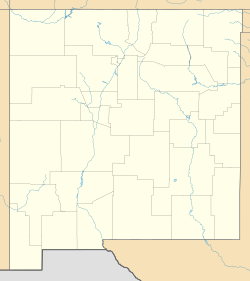Rio Brazos (New Mexico) facts for kids
Quick facts for kids Rio Brazos |
|
|---|---|
|
Location of the mouth of Rio Brazos in New Mexico
|
|
| Country | United States |
| State | New Mexico |
| Physical characteristics | |
| Main source | Confluence of East and West Forks Brazos Meadows, San Juan Mountains 9,957 ft (3,035 m) 36°52′30″N 106°22′29″W / 36.87500°N 106.37472°W |
| River mouth | Rio Chama Near Tierra Amarilla 7,287 ft (2,221 m) 36°52′30″N 106°22′29″W / 36.87500°N 106.37472°W |
| Length | 42 mi (68 km) |
| Basin features | |
| Basin size | 150 sq mi (390 km2) |
| Tributaries |
|
The Rio Brazos is a river that flows through northern New Mexico in the United States. It is about 42 miles (68 km) long. This river starts in the Tusas Mountains, which are part of the larger San Juan Mountains. It then flows generally southwest until it joins the Rio Chama, which is part of the even bigger Rio Grande river system.
Where the River Flows
The Rio Brazos actually begins when two smaller streams meet. These are the West Fork, which is about 8.74 miles (14.07 km) long, and the East Fork, about 8.44 miles (13.58 km) long. They come together at a place called Brazos Meadows, just outside the Carson National Forest.
For its first few miles, the river moves slowly. It winds its way through the mountains like a gentle stream. But then, east of Brazos Peak, it suddenly turns west. Here, it enters a huge canyon known as the Brazos Box. This canyon is one of the biggest in New Mexico, reaching depths of more than 1,400 feet (430 m)!
Inside the Brazos Box, the river flows past the impressive Brazos Cliffs. It also gets more water from other streams like Gavilan Creek and Encinado Creek. An unnamed stream also joins, creating Brazos Falls. This waterfall is said to be New Mexico's highest, with water dropping a total of 2,400 feet (730 m)!
As the river leaves the mountains, northeast of Tierra Amarilla, Chavez Creek adds more water. The Rio Brazos then passes by small towns like Ensenada, Brazos, and Los Ojos. Finally, it flows into the Rio Chama, about 90 miles (140 km) northwest of Santa Fe.
River Life and Use
The Rio Brazos is a perennial stream, which means it flows all year round. Its water levels are highest in April and early May. This is because snow from the mountains melts and flows into the river. Sometimes, heavy summer thunderstorms can cause sudden flash floods.
Most of the river is a great place for fishing. You can find brown and rainbow trout here. The upper part of the river, especially, is known as one of the best high-meadow fishing spots in New Mexico. However, much of the land around the river is privately owned. This makes it hard for people to access the river for fun activities.
Even though most of the Brazos flows through wild areas, people use a lot of its water. In the last 5 miles (8.0 km) of the river, many acequias (which are old irrigation ditches) take water away. Because of this, this part of the river can become very small, sometimes just a trickle, during dry seasons.
The U.S. Environmental Protection Agency (EPA) has noted that the water quality in the last 3.52 miles (5.66 km) of the river is "impaired." This means the water isn't as clean as it should be. The main reasons for this are water runoff from farms and the large amount of water taken out of the river in the summer.


